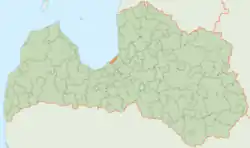Carnikava Municipality
Carnikava Municipality (Latvian: Carnikavas novads) is a municipality in Vidzeme, Latvia. The municipality was formed in 2006 by reorganization of Carnikava Parish of the Riga District, with the administrative centre being Carnikava. After the municipal reform of 2009, the districts were abolished and the Municipality became a national administrative unit.
Carnikava Municipality
Carnikavas novads | |
|---|---|
 Flag  Coat of arms | |
 | |
| Country | |
| Formed | 2006 |
| Centre | Carnikava |
| Government | |
| • Council Chair | Daiga Mieriņa (LZS) |
| Area | |
| • Total | 80.2 km2 (31.0 sq mi) |
| Population (2009)[2] | |
| • Total | 6,261 |
| • Density | 78/km2 (200/sq mi) |
| Postal code | LV-2163 |
| Website | www |
The population in 2009 was 6,261 people.
Nature:
The total area of the county is 80.2 square kilometers, which is the third smallest county in Latvia after Saulkrasti and Stopiņi counties, moreover, most of it is covered by forests, but a quarter of the total area is used for agriculture. Carnikava is known for its "Seaside Nature Park", which is part of the European Union's Natura 2000 network of specially protected areas and which contains a number of protected plant species. Many plant species characteristic of non-draining, clear-water lakes have been found in Lake Ummja: Dortmanis lobelia, lakes, etc. Several rare bat species have been found near Garezers. The park occupies about one-fifth of the entire territory of the county. There are five rivers and canals, eight lakes and four lake islands in the territory of Carnikava district. The region has a 19-kilometer-long beach along the Vidzeme coast of the Gulf of Riga from Kalngale to Lilaste.
Rivers: Gauja, Langa, Eimura Canal, Dzirnupe, Vecgauja
See also
References
- The Ministry of Regional Development and Local Government of the Republic of Latvia Archived February 7, 2014, at the Wayback Machine
- "The Central Election Commission of Latvia". Archived from the original on 2012-04-06. Retrieved 2009-07-30.